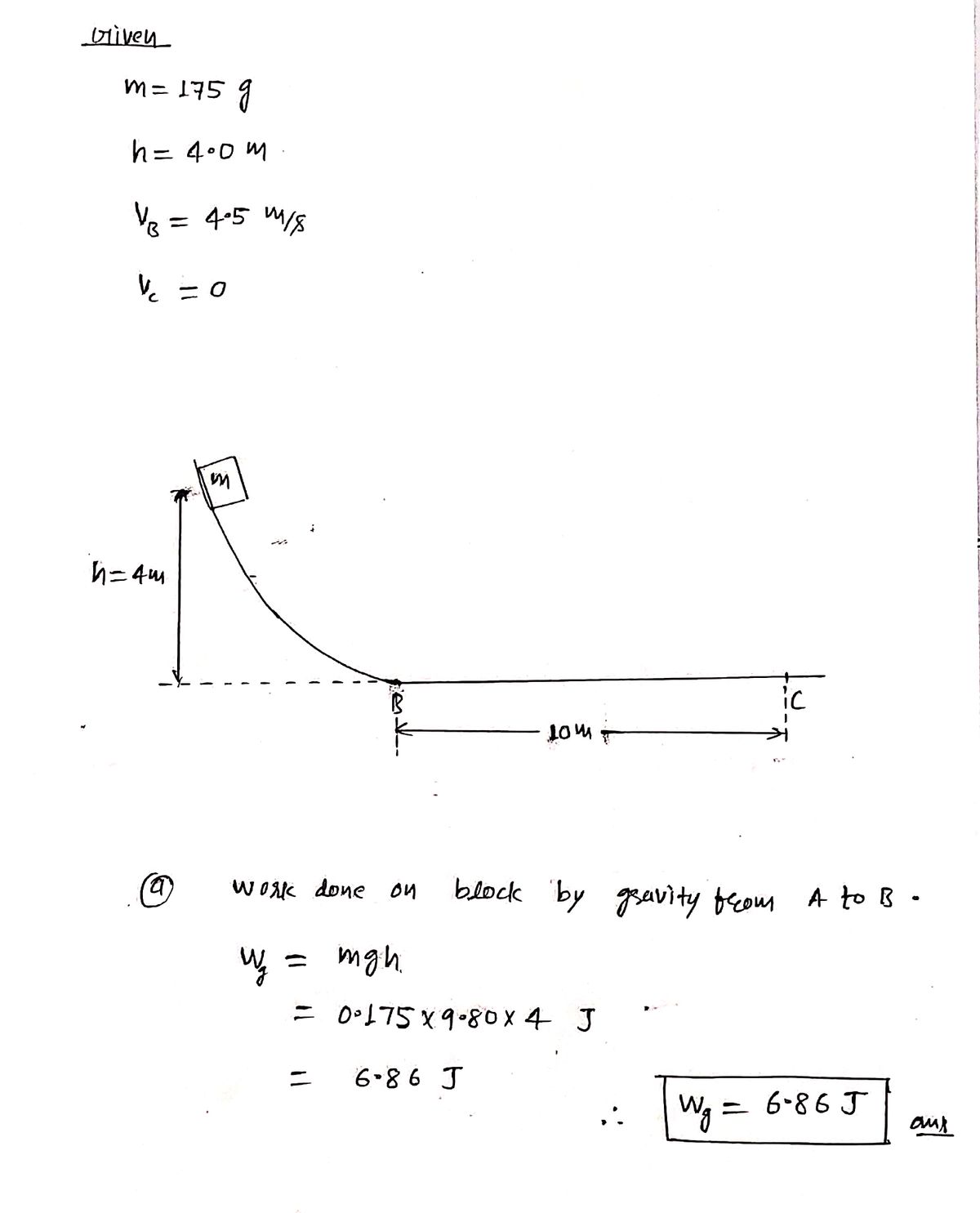4.0 m above the ground (point A). The block then slides to point B where its speed is 4.5 m/s then slides along the horizontal surface a distance 10 m before coming to rest at point C. (See figure) What is the work done on the block by gravity (in J) along the curved surface between points A and B? What is the work done on the block by friction (in J) along the curved surface between points A and B? What is the work done on the block by friction (in J) along the horizontal surface between points B and C? What is the coefficient of
4.0 m above the ground (point A). The block then slides to point B where its speed is 4.5 m/s then slides along the horizontal surface a distance 10 m before coming to rest at point C. (See figure) What is the work done on the block by gravity (in J) along the curved surface between points A and B? What is the work done on the block by friction (in J) along the curved surface between points A and B? What is the work done on the block by friction (in J) along the horizontal surface between points B and C? What is the coefficient of
College Physics
11th Edition
ISBN:9781305952300
Author:Raymond A. Serway, Chris Vuille
Publisher:Raymond A. Serway, Chris Vuille
Chapter1: Units, Trigonometry. And Vectors
Section: Chapter Questions
Problem 1CQ: Estimate the order of magnitude of the length, in meters, of each of the following; (a) a mouse, (b)...
Related questions
Topic Video
Question
A small block of mass 175 g starts at rest 4.0 m above the ground (point A). The block then slides to point B where its speed is 4.5 m/s then slides along the horizontal surface a distance 10 m before coming to rest at point C. (See figure)
What is the work done on the block by gravity (in J) along the curved surface between points A and B?
What is the work done on the block by friction (in J) along the curved surface between points A and B?
What is the work done on the block by friction (in J) along the horizontal surface between points B and C?
What is the coefficient of kinetic friction along the horizontal surface?

Transcribed Image Text:### Diagram Explanation
The image depicts a section of a path or track involving a curved incline followed by a horizontal straight path. The key components of the diagram are as follows:
- **Point A**: This is the starting point located at the top of the curve. At this point, there is an object, represented as a blue box, commencing its motion.
- **Curved Incline**: The path from Point A downward is curved, suggesting a potential role of gravity in accelerating the object as it moves downwards.
- **Vertical Height**: From Point A to the horizontal line (at the bottom of the curve), the vertical distance is marked as 4.0 meters, indicating the height from which the object begins to descend.
- **Point B to Point C**: After the curve, the path continues in a horizontal straight line for 10 meters. Point B marks the transition from the curve to this straight path, while Point C is the endpoint of the straight section.
In summary, the diagram illustrates a path consisting of an initial 4.0-meter high curve leading into a 10-meter horizontal stretch. This setup could be used to explore principles of physics such as gravitational potential energy, kinetic energy, and friction.
Expert Solution
Step 1

Step by step
Solved in 3 steps with 2 images

Knowledge Booster
Learn more about
Need a deep-dive on the concept behind this application? Look no further. Learn more about this topic, physics and related others by exploring similar questions and additional content below.Recommended textbooks for you

College Physics
Physics
ISBN:
9781305952300
Author:
Raymond A. Serway, Chris Vuille
Publisher:
Cengage Learning

University Physics (14th Edition)
Physics
ISBN:
9780133969290
Author:
Hugh D. Young, Roger A. Freedman
Publisher:
PEARSON

Introduction To Quantum Mechanics
Physics
ISBN:
9781107189638
Author:
Griffiths, David J., Schroeter, Darrell F.
Publisher:
Cambridge University Press

College Physics
Physics
ISBN:
9781305952300
Author:
Raymond A. Serway, Chris Vuille
Publisher:
Cengage Learning

University Physics (14th Edition)
Physics
ISBN:
9780133969290
Author:
Hugh D. Young, Roger A. Freedman
Publisher:
PEARSON

Introduction To Quantum Mechanics
Physics
ISBN:
9781107189638
Author:
Griffiths, David J., Schroeter, Darrell F.
Publisher:
Cambridge University Press

Physics for Scientists and Engineers
Physics
ISBN:
9781337553278
Author:
Raymond A. Serway, John W. Jewett
Publisher:
Cengage Learning

Lecture- Tutorials for Introductory Astronomy
Physics
ISBN:
9780321820464
Author:
Edward E. Prather, Tim P. Slater, Jeff P. Adams, Gina Brissenden
Publisher:
Addison-Wesley

College Physics: A Strategic Approach (4th Editio…
Physics
ISBN:
9780134609034
Author:
Randall D. Knight (Professor Emeritus), Brian Jones, Stuart Field
Publisher:
PEARSON